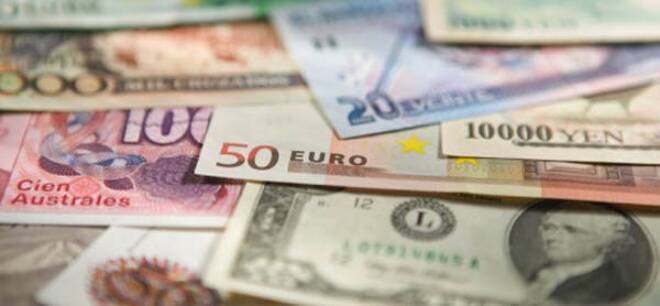Advertisement
Advertisement
U.S. Dollar Ekes Out Small Gain, but Investors Worried About Falling Treasury Yields
By:
The U.S. Dollar posted a two-sided trade last week, but still managed to eke out a small gain. However, the weak close on Friday suggests that downside
The U.S. Dollar posted a two-sided trade last week, but still managed to eke out a small gain. However, the weak close on Friday suggests that downside momentum may be building.
September U.S. Dollar Index futures settled the week at 96.942, up 0.076 or +0.08%.
Early in the week, the dollar was driven higher by the previous week’s hawkish interest rate decision and monetary policy statement. Several Fed speakers also issued hawkish commentary about the direction of interest rates. However, weaker-than-expected economic data weighed on the bullish sentiment, driving down U.S. Treasury yields, thereby making the U.S. Dollar a less-desirable investment.
The U.S. Dollar topped last week on Tuesday as tumbling oil prices pushed down U.S. yields. The big drop in oil prices drove the 10-year Treasury yield sharply lower, reversing a large portion of the gains it made after the Fed left the door open for another rate increase this year.
Lower crude oil prices weaken inflationary pressures which could force the Fed to pass on additional rate hikes later in the year.
Existing home sales came in better-than-expected at 5.62 million units, but late in the week, Flash Manufacturing PMI disappointed by coming in at 52.1, below the 53.1 forecast and 52.7 previous read. Flash Services PMI also came in below expectations. However, the week ended with New Home Sales beating the previous read and forecast.
In other news, Dallas Federal Reserve President Robert Kaplan said the low Treasury yields suggest the markets expect “sluggish” growth ahead. He also said “I think there’s a point that if the 10-year Treasury rate stays at the level it’s at, we’ve got to be very careful about how we remove accommodation.”
St. Louis Fed President James Bullard said the Fed can afford to stop raising short-term interest rates and take a wait-and-see stance to see where the economy is headed and how policy debates in Washington play out in coming quarters.
Cleveland Fed President Loretta Mester said the Fed must continue raising interest rates to avoid inflation getting out of hand and causing a recession, according to Reuters.
Australian Dollar
The Australian Dollar finished lower last week. Sellers were reacting to the Reserve Bank of Australia’s June 6 monetary policy meeting minutes. The RBA minutes covered the same topics previously highlighted. The RBA said that housing and employment merit watching, as does the Australian Dollar strength.
The AUD/USD settled at .7568, down 0.0047 or -0.62%.
The steep drop in crude oil also weighed on the commodity-linked Aussie Dollar.
New Zealand Dollar
The New Zealand Dollar rose last week after the central bank held official cash rates at record lows but sounded less dovish than bearish investors had expected.
The NZD/USD settled at .7280, up 0.0032 or +0.45%.
Some investors were looking for the Reserve Bank of New Zealand to do more to talk down the currency which had gained 3 percent since May. However, the RBNZ only said a lower exchange rate “would help rebalance the growth outlook.” Investors were surprised the RBNZ Governor did not say that a lower currency was “needed” for rebalancing to occur.
The RBNZ also reiterated its policy would be accommodative for a “considerable period,” after the economy grew a disappointing 0.5 percent in the first quarter.
Japanese Yen
The Dollar/Yen closed higher for the week with the outlook for higher U.S. interest rates helping with most of the gains. There was a setback late in the week as investors reacted to dovish Fed commentary, falling oil prices and weak U.S. economic data. Falling Treasury yields also drove down the U.S. Dollar as investors priced in the possibility that weak inflation would curtail the Fed’s plan to raise rates later in the year.
The USD/JPY closed the week at 111.255, up 0.403 or +0.36%.
The Bank of Japan also released the minutes of its April meeting. Policymakers said that under the bank’s asset-purchase program, the amount of government debt purchases would fluctuate, but this did not pose a problem.
The minutes also noted that members were optimistic about exports and industrial production.
About the Author
James Hyerczykauthor
James Hyerczyk is a U.S. based seasoned technical analyst and educator with over 40 years of experience in market analysis and trading, specializing in chart patterns and price movement. He is the author of two books on technical analysis and has a background in both futures and stock markets.
Advertisement
